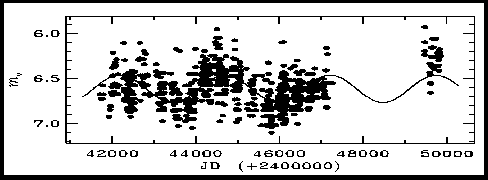
from VSSC89
NO Aur (HR 1939, HD 37536, BD+31 1049, SAO 58322) was discovered to be variable by Eggen (1967) on the basis of 5 photoelectric observations made over about 80 days in 1965-66. Only the last and brightest point is obviously different but there is clearly significant variation on this time scale. Isles (1967, 1972) also drew attention to the possible variability of this star by a few tenths of a mag and it was used by the VSS as comparison N for observations of "Andrews' Star". Despite the brightness of the star practically no further photoelectric photometry has been published. In the GCVS (Kholopov et al. 1985) NO Aur appears as an Lc variable with a magnitude range, V = 6.13 - 6.32, entirely on the basis of Eggen's photometry. The spectral type is given as M2 S Iab and in some recent papers on stellar populations it is also regarded as a supergiant (eg. Hickman et al. 1995). However, in similar studies it appears as a giant M3 III and this seems to be the prevailing view (Groenewegen 1993, Eggen 1992, Brown et al. 1990). There is no doubt that the star is chemically peculiar. It is an S-type star, which means that the atmosphere contains heavy elements from the s-process. This highly processed nuclear material is brought to the surface of the star by convection currents that periodically reach deep into the interior. In addition it also shows technetium (Tc) which is usually associated with the so-called ‘third dredge up’. All this implies that the star is relatively massive and highly evolved. Of more immediate interest is the conclusion by Smith & Lambert (1987) that S-type stars with Tc are pulsating asymptotic giant branch (AGB) stars.
NO Aur was added to the VSS programme in 1973 and observed to 1988, and again in 1995 by a lone observer. There are only a relatively small number of observations, 1041, and the list of observers is given in Table 1. The raw observations are spread fairly evenly between mv 6.2 and 7.0 but there is a definite suggestion of long term activity. The power spectrum of the raw data shows a strong period at ~ 2500 days, and even after the personal bias of the observers has been removed assuming that the star is constant, as in previous papers in the Circulars, this variation persists. The personal biases and the mean light curve were recalculated using 500 day bins and the power spectrum of the de-biased data is shown in Figure 1.The best fit period is 2520 ± 40 days and this is plotted through the data in Figure 2. The fit is not perfect but given that these are visual observations and the amplitude is only 0.30 mag, the scatter is not unreasonable.
Figure 1: The DFT power spectrum of the de-biased data using 500 day bins. The dominant feature occurs at a period of 2500 days.

Table 1: List of observers S W Albrighton, C M Allen, M R Bell, T Brelstaff, M J Currie, R B I Fraser, M Hather, A J Hollis, D Hufton, G M Hurst, G J Kirby, M Lunn, T Markham, R H McNaught, B R M Munden, I P Nartowicz, N Richardson, M D TaylorFigure 2: The corrected light curve of NO Aur from the VSS data with a period of 2520 days plotted through the data.

Before a periodic variation can be claimed for this star a couple of points should be made. Firstly, this variation is on the limit of detection and at best only three cycles have been covered; only two have complete coverage. Secondly the recent observations are due to a single observer and as they are brighter than the average will exert a strong influence on the solution, although they are consistent with the solution derived from the early data alone. It should also be remembered that the photoelectric data show significant variation on a time scale of 80 days which cannot be accounted for by a long period variation.
Stars with dominant periods of a few thousand days are extremely rare so if this period is correct then NO Aur immediately assumes some significance. In the GCVS the only stars with similar periods are T Per, M2 Iab, SRc 2430 days, CQ Cas, M6.5, SRb 2300 days and Betelgeuse, M2 Iaev, SRc 2335 days (see Markham 1995). All these stars also have other periods in the few hundred day range. In the 3rd edition of the GCVS T Per is given a primary period of 326 days so even among these stars there is confusion over which period dominates. Many semi-regular variables have secondary periods in the few thousand day range, for example mu Cep (Brelstaff et al. 1996), these are typically 7-10 times the primary period. It therefore seems more likely that NO Aur is a semi-regular with a short period which is what is seen in the photoelectric data, and a long period which is apparent in the visual observations. Which of these periods dominates will require more observations to determine, but this is not one for the visual observer.
References
Brelstaff T., Lloyd C., Markham T. & McAdam D., 1996, J.BAA in press
Brown J.A. et al., 1990, AJ 99, 1930
Eggen O.J., 1967, ApJ 104, 275
Eggen O.J., 1992, AJ 104, 275
Groenewegen M.A.T., 1993, A&A 271, 180
Hickman M.A., Sloan G.C. & Canterna R., 1995, AJ 110, 2910
Isles J.E., 1967, TA 4, 115 (#42)
Isles J.E., 1972, TA 8, 133 (#91)
Kholopov P.N. et al., 1985, General Catalogue of Variable Stars,
4th edn., Moscow
Markham T., 1995, VSS Circ 82, 6
Smith V.V. & Lambert D.L., 1987, AJ 94, 977
Footnote; The original article misquoted NO Aur as type Lb.